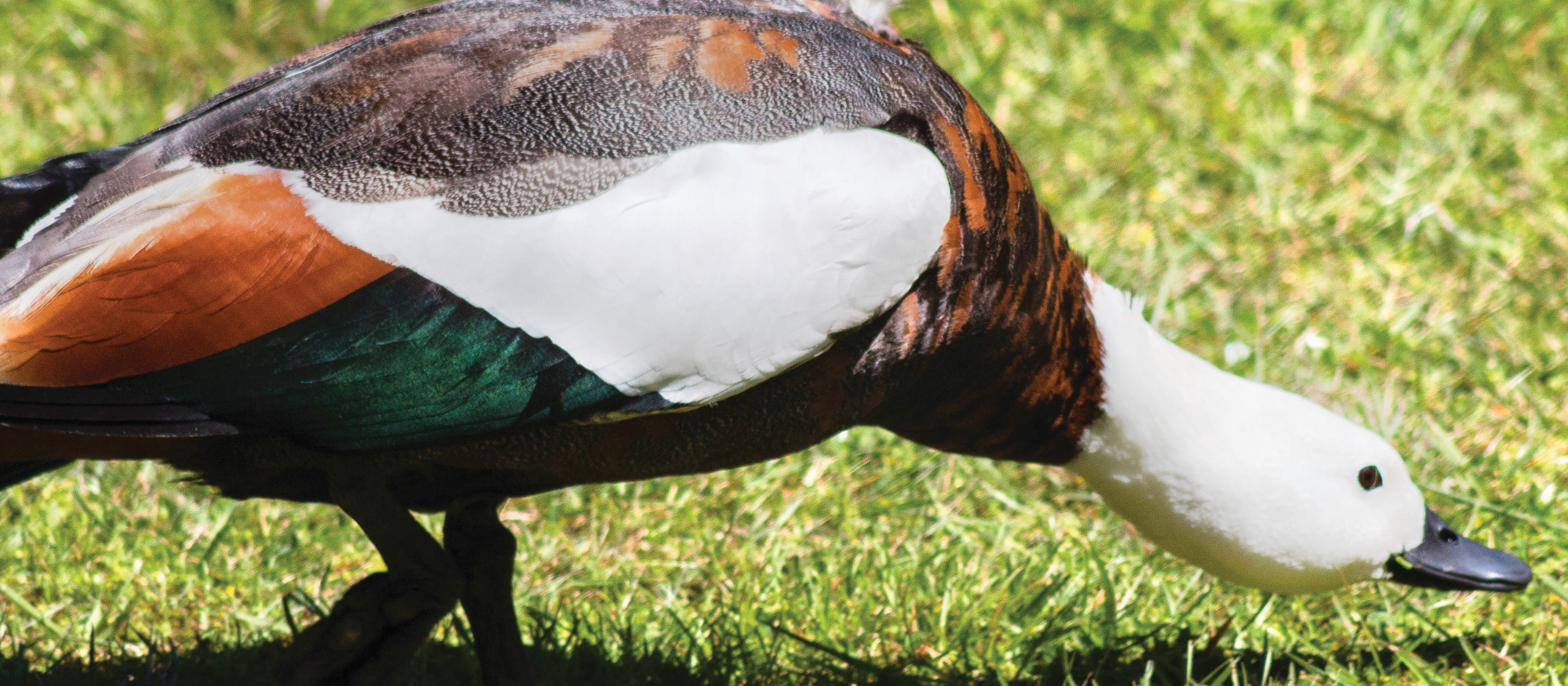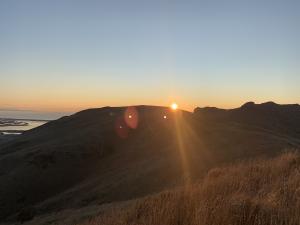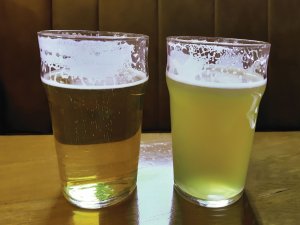Respiratory physician Lutz Beckert considers chronic obstructive pulmonary disease management, including the prevention of COPD, the importance of smoking cessation and pulmonary rehabilitation, and the lifesaving potential of addressing treatable traits. He also discusses the logic of inhaler therapy, moving from single therapy to dual and triple therapy when indicated, as well as other aspects of management
My bird of the year: Loud, lamenting and loyal
My bird of the year: Loud, lamenting and loyal

Fiona Cassie makes the case for the pūtangitangi – our cacophonic, colourful and endearingly “couply” paradise shelduck – as a candidate for Bird of the Year
- The paradise shelduck, or pūtangitangi, is New Zealand’s only shelduck.
- It is endemic to New Zealand.
- The female is the most striking in appearance.
- Couples mate for life, and co-parent their ducklings.
My fondness for the paradise shelduck was initially tepid at best.
These birds competed with stock for grazing and had few fans in the Taranaki farming community where I grew up.
The paradise shelduck’s nickname “parrie” was not used affectionately. It was often muttered in the same breath as the word “shotgun”.
And I tended to take notice of the birds only when they were flying noisily overhead.
Now I know their mournful, distinctive call inspired their name in te reo Māori: pūtangitangi (tangi in the sense of lament for the dead.)
If you are wondering what a shelduck is – it’s a genus of goose-like ducks with long necks and legs.
They started waddling their way into my affections nearly two decades ago, when we moved into our current home near a riverside park.
It started with a couple of the ducks who, every autumn, would arrive in our corner of the park just as the large oak trees started scattering acorns onto the street.
They would watch as cars on the school run crunched and squished the acorns. As the traffic died away, they would waddle out and partake of a freshly crushed nut breakfast.
I began keeping an eye out for them, and the other duck couples calling and “chatting” to each other, as they claimed their own territory in the park.
After a quick Google, my affection and respect for them only grew.
My early rural prejudice had led me to assume the “parrie” wasn’t a native bird. Not only is the pūtangitangi native, it is endemic and unique to New Zealand. (Unlike the native pukeko, a contemporary Kiwi icon found on tea towels and coffee keepcups and, I was shocked to discover, an Australasian creature.)
When I realised that paradise ducks mate for life, the romantic in me was touched. And my heart would stop a little if I ever saw just one duck standing solitary in the park.
Another endearing feature is that the couples raise their cute, striped ducklings together. Parenting apparently ends when they flock once a year to summer moulting sites before couples return to their breeding patch.
It is at the summer moulting that, Te Ara Encyclopaedia of New Zealand tells me, Māori traditionally caught and preserved pūtangitangi in their own fat as an important food source.
Early European settlers renamed the duck “paradise” then nearly hunted them to extinction, but numbers recovered and the paradise shelduck is one of our few native bird species to have managed to thrive with the rise in pastoral farming.
They are also one of the few native birds legally “game” during duck-hunting season. I would like to put my head in the sand over that, and am always relieved when I see the park filling up with ducks of all hues and sizes as 1 May gets closer.
Moving on…the feminist fashionista in me also loves that, unlike most bird species, it is the female which has the most striking plumage – a white head and chestnut body with touches of green, grey and white. The lads are also quite fetching, if more subdued, with their black head and dash of green iridescence.
Both sexes are vocal, but sing to a different song sheet, with the male variously described as making a “zonk” or “honk” sound compared with the female’s “zeek” or “heek”.
So what’s not to love about the pūtangitangi – a smart, demonstrative and colourful survivor that is also a loyal partner and parent.
But ducks of any plumage have failed to take out the annual Forest & Bird-hosted Bird of the Year competition in its 15-year history.
Parrots have dominated the competition, winning the title four times. The admittedly charming kākāpō has come out on top twice, and the kea and kākāriki have managed one win apiece.
A penguin coalition and preferential voting in 2019 helped the hoiho smash the “feathered ceiling” as the first seabird to win. Numerous forest birds have flittered to the top but no duck is yet to waddle onto the winner’s podium. I have a friend whose duck of choice is the whio – the rapids-riding blue duck that squeezed itself into the top 10 (coming in ninth) last year. Maybe it’s time for a duck-voting block. Are you with me?








![Barbara Fountain, editor of New Zealand Doctor Rata Aotearoa, and Paul Hutchison, GP and senior medical clinician at Tāmaki Health [Image: Simon Maude]](/sites/default/files/styles/thumbnail_cropped_100/public/2025-03/Barbara%20Fountain%2C%20editor%20of%20New%20Zealand%20Doctor%20Rata%20Aotearoa%2C%20and%20Paul%20Hutchison%2C%20GP%20and%20senior%20medical%20clinician%20at%20T%C4%81maki%20Health%20CR%20Simon%20Maude.jpg?itok=-HbQ1EYA)
![Lori Peters, NP and advanced health improvement practitioner at Mahitahi Hauora, and Jasper Nacilla, NP at The Terrace Medical Centre in Wellington [Image: Simon Maude]](/sites/default/files/styles/thumbnail_cropped_100/public/2025-03/2.%20Lori%20Peters%2C%20NP%20and%20advanced%20HIP%20at%20Mahitahi%20Hauora%2C%20and%20Jasper%20Nacilla%2C%20NP%20at%20The%20Terrace%20Medical%20Centre%20in%20Wellington%20CR%20Simon%20Maude.jpg?itok=sUfbsSF1)
![Ministry of Social Development health and disability coordinator Liz Williams, regional health advisors Mary Mojel and Larah Takarangi, and health and disability coordinators Rebecca Staunton and Myint Than Htut [Image: Simon Maude]](/sites/default/files/styles/thumbnail_cropped_100/public/2025-03/3.%20Ministry%20of%20Social%20Development%27s%20Liz%20Williams%2C%20Mary%20Mojel%2C%20Larah%20Takarangi%2C%20Rebecca%20Staunton%20and%20Myint%20Than%20Htut%20CR%20Simon%20Maude.jpg?itok=9ceOujzC)
![Locum GP Helen Fisher, with Te Kuiti Medical Centre NP Bridget Woodney [Image: Simon Maude]](/sites/default/files/styles/thumbnail_cropped_100/public/2025-03/4.%20Locum%20GP%20Helen%20Fisher%2C%20with%20Te%20Kuiti%20Medical%20Centre%20NP%20Bridget%20Woodney%20CR%20Simon%20Maude.jpg?itok=TJeODetm)
![Ruby Faulkner, GPEP2, with David Small, GPEP3 from The Doctors Greenmeadows in Napier [Image: Simon Maude]](/sites/default/files/styles/thumbnail_cropped_100/public/2025-03/5.%20Ruby%20Faulkner%2C%20GPEP2%2C%20with%20David%20Small%2C%20GPEP3%20from%20The%20Doctors%20Greenmeadows%20in%20Napier%20CR%20Simon%20Maude.jpg?itok=B0u4wsIs)
![Rochelle Langton and Libby Thomas, marketing advisors at the Medical Protection Society [Image: Simon Maude]](/sites/default/files/styles/thumbnail_cropped_100/public/2025-03/6.%20Rochelle%20Langton%20and%20Libby%20Thomas%2C%20marketing%20advisors%20at%20the%20Medical%20Protection%20Society%20CR%20Simon%20Maude.jpg?itok=r52_Cf74)
![Specialist GP Lucy Gibberd, medical advisor at MPS, and Zara Bolam, urgent-care specialist at The Nest Health Centre in Inglewood [Image: Simon Maude]](/sites/default/files/styles/thumbnail_cropped_100/public/2025-03/7.%20Specialist%20GP%20Lucy%20Gibberd%2C%20medical%20advisor%20at%20MPS%2C%20and%20Zara%20Bolam%2C%20urgent-care%20specialist%20at%20The%20Nest%20Health%20Centre%20in%20Inglewood%20CR%20Simon%20Maude.jpg?itok=z8eVoBU3)
![Olivia Blackmore and Trudee Sharp, NPs at Gore Health Centre, and Gaylene Hastie, NP at Queenstown Medical Centre [Image: Simon Maude]](/sites/default/files/styles/thumbnail_cropped_100/public/2025-03/8.%20Olivia%20Blackmore%20and%20Trudee%20Sharp%2C%20NPs%20at%20Gore%20Health%20Centre%2C%20and%20Gaylene%20Hastie%2C%20NP%20at%20Queenstown%20Medical%20Centre%20CR%20Simon%20Maude.jpg?itok=Z6u9d0XH)
![Mary Toloa, specialist GP at Porirua and Union Community Health Service in Wellington, Mara Coler, clinical pharmacist at Tū Ora Compass Health, and Bhavna Mistry, specialist GP at Porirua and Union Community Health Service [Image: Simon Maude]](/sites/default/files/styles/thumbnail_cropped_100/public/2025-03/9.%20Mary%20Toloa%2C%20Porirua%20and%20Union%20Community%20Health%20Service%20in%20Wellington%2C%20Mara%20Coler%2C%20T%C5%AB%20Ora%20Compass%20Health%2C%20and%20Bhavna%20Mistry%2C%20PUCHS%20CR%20Simon%20Maude.jpg?itok=kpChr0cc)